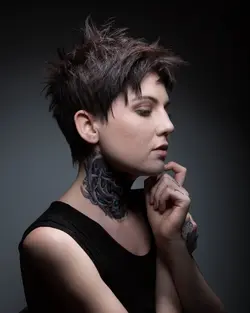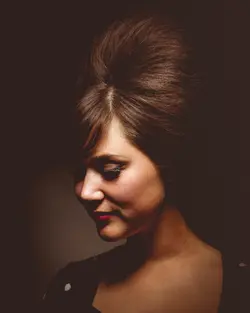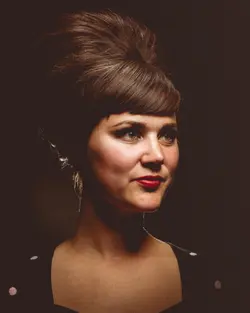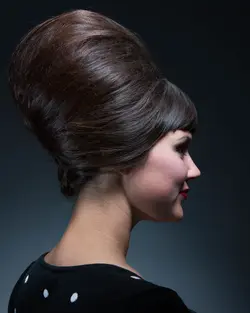QUESTIONS:
andrewdoeshair said:
I think I'm going to buy a black backdrop. I keep trying to get a dark background from my white wall and I think I'm losing too much information on my subject because of that. I've read that a gray backdrop can be made to look black or white pretty easily, but since I have a white wall already I figure I have the white abilities of a gray backdrop covered, and that
a black backdrop will probably be better at being black than a gray backdrop would. Am I correct in my hopes about such a tool? Could I move these lights back to get less contrast on her and still have a black backdrop look dark enough for what I might have been going for here?
View attachment 137045
Okay, there are two questions in there. First answer: If you had swapped in a solid black velvet fabric for the white wall in this shot, it would have been pitch-black in the upper left corner, and would have had a very slight lightening to a dark,dark gray where the most light hit the fabric. If you had swapped the white wall for a thunder gray background, it would have been very dark,with sublte tone gradation, yet lighter than the black background.
The second question is trickier to answer. You asked, "Could I move these lights back to get less contrast on her and still have a black backdrop look dark enough for what I might have been going for here?"
First off, you write
these lights? Let's assume there is just one, main light that lights her. The answer you're looking for is a bit conterintuitive. Moving the main light back, farther from her, would lessen its intensity on her, so you'd have to open up the aperture to get the right exposure on her face, and in doing so, you would ALSO be exposing the background more. If the light were to be placed farther from her
and the background, the degree and the rate of light fall-off behind her
would be slower, and thus, opening up the f/stop to get her face exposed properly would actually INCREASE the exposure for the background at the same time! Again, the Inverse Square Law means you'd want to bring the lights CLOSER to her, so the rate of fall-off in intensity would be more-rapid, and you would also need to close the f/stop down, say from f/8 to f/13, and that would create a darker background!
Let's be clear: the 10 x 10 foot distance is simply too short a distance to work freely, and to be able to easily and casually make white into black through fall-off based on pure distance to the backdrop. You're kind of trapped in the intermediate distances where there will almost always be "some" light hitting the background, and where even small differences in the key light modifier's type, and its distance, can make a big impact. First off: GRIDS. Grids will increase the rate of fall-off very hugely, so you need to specify what "these lights" actually are, like 31x 31-inch gridded softbox, or 22-inch gridded beauty dish, etc.. Using a gridded key light will keep the light from hitting the backdrop, and will tremendously restrict the distance the light will be visible behind the subject. A gridded softbox or gridded beauty dish as the key light will make a white wall drop-off to gray or black much more rapidly than say, a reflecting umbrella would; the umbrella would tend to light the subject AND also light the background with a "normal rate"of loss of intensity over distance.
Secondly: In post #51, the look you were going for can be arrived at by not allowing much light to hit a white wall, OR by allowing a tiny bit of light to strike jet black, OR by allowing an intermediate amount of light to strike a gray backdrop. In a SMALL studio, it's often easier to work with a dark backdrop and add a background light, or to let some of the un-gridded main or key light's beam to hit the subject and the back wall, using a single light to light both the subject and the background.
I'm not trying to diss your 10x10 foot space, but you're in a VERY tricky position where the subject simply must be fairly close to the back wall, and where the Inverse Square Law is transitioning from RAPID rate of light fall-off behind the subject to only a moderate rate of fall-off behind the subject distance. Moving the light unit CLOSER to the subject makes the light softer, and yet, increases the amount of darkness behind the subject. At close light-to-subject distance, scooting the light just six inches closer can mean an entire f/stop smaller on the lens will be needed to get the right skin exposure, say from f/11 to f/16. Moving the light close to the face, and shifting from f/11 to f/16 will darken the background quite a bit when you are in a 10x10 foot room, with the light 4 feet from the face and six feet to the back wall.
So, what I'm laboriously trying to write out is that 1)in a SMALL shooting and lighting and posing area, it's very challenging to do the full, total gamut of key-shifting by using only a white wall or paper; black paper or fabric,or gray, either tone, will be much easier to darken than white paper. And 2)there is the element of lighting the backdrop by either A)Adding light to it or B)keeping light from hitting it and 3) The Inverse Square Law actually works "backwards" from what most people would assume, as it relates to how bright the background will be based on moving the light father away because 4) the exposure given to the sensor is based on how much light the face gets hit by, and not how much light hits the background wall.
This is tricky to write about. Mark Wallace at
Adorama TV has a nice video that might make the Inverse Square Law and the CHANGE in the rate of light's fall-off over distance make more sense to those who have difficulty understanding why the 10x10 foot shooting area makes key-shifting through fall-off such a tricky predicament. You are working in a VERY challenging distance range to be able to wrangle light at the level you want to be at. You're right on the cut-off of where fall-off moves from a rapid rate, to the moderate rate; you would need 18-20-25 feet to get into the zone where there is no measurable fall-off in intensity over a four-foot run of distance, which is around the distance I think you have behind your haircut subjects and the back wall,meaning the lights themselves are no more than 6 feet from the haircuts. This is a very demanding distance for light-to-subject, and even small changes in distances have a BIG impact on final exposures, and on background tones.
Again, you're in the distance zone where the Inverse Square Law makes foreground and background light level differences VERY significant, and where the rate, and the absolute degree, of light's fall-off in intensity is very high. This is why white, gray, and black backgrounds could be so,so handy to have,depending on what background effect you want to have in the final image.













![[No title]](/data/xfmg/thumbnail/33/33027-0118cfc4034a37ef267ca6f8aa2fe04a.jpg?1734163031)

![[No title]](/data/xfmg/thumbnail/33/33029-f4556b4c89cecbad12ebe6b782a51ef5.jpg?1734163040)






